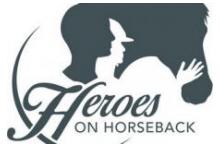Heroes on Horseback’s (HOH) purpose is to enrich the lives of special needs individuals in the Lowcountry through equine assisted therapy. During the last year, HOH served children and adults with disabilities including autism, cerebral palsy, downs syndrome, ADD and ADHD, learning disabilities, muscular dystrophy, speech impairment, multiple sclerosis, stroke, brain trauma, and many others. The organization is now in its fifteenth year of operation. During the school year, HOH provides ... Read More
Heroes on Horseback’s (HOH) purpose is to enrich the lives of special needs individuals in the Lowcountry through equine assisted therapy. During the last year, HOH served children and adults with disabilities including autism, cerebral palsy, downs syndrome, ADD and ADHD, learning disabilities, muscular dystrophy, speech impairment, multiple sclerosis, stroke, brain trauma, and many others. The organization is now in its fifteenth year of operation. During the school year, HOH provides special needs children with therapeutic riding and associated activities five days per week, with additional therapeutic riding programs for six weeks in the summer. During the school year, HOH works with the Special Olympics program to serve most of the special education students in the Beaufort county school district. Our program consists of therapeutic riding, natural horsemanship, and equine-inspired arts and crafts, which together provide the special needs child with a combination of physical, emotional, and intellectual empowerment. Additionally, we provide Saturday programming for children not involved in the public school district. Special needs adults, including disabled veterans, also participate in equine-assisted therapeutic riding during the week.
Our participants benefit from our program through increased confidence, improved concentration, better self-awareness and self-discipline, and improved posture, balance, strength, flexibility and eye/hand coordination. The horse provides freedom of movement and excitement that no clinical setting can duplicate. Many of these benefits occur after only a couple of weeks of equine therapy. The improvements of many of our participants include the ability to take their first unassisted steps and a vastly improved verbal communications, including, in some cases, their first spoken words.
Through our equine-assisted therapy, there are significant positive impacts to our community. Many of our youth participants perform much better in the classroom and are better functioning at home, as their behavioral and physical improvements transfer from their experiences at our equine facility to their personal lives. There are numerous cases of special needs students graduating from high school and becoming employed at local businesses including hotels, retail stores, and grocery stores. One local graduate was recently named hospitality employee of the year for Hampton Inns. The successes of three of our participants have brought much attention to our community through their participation in the Special Olympics World Games in 2011 in Greece, and in 2015 in Los Angeles. These equestrian athletes brought back a total of two gold, one silver and two bronze medals from Greece in 2011 and Los Angeles in 2015.
As a premier-accredited center of PATH, Int’l, we are provided guidelines that require the establishment of goals and objectives for each participant after the initial assessment of the rider, as well as consultation with the parents, teachers, caregivers, and medical professionals. Evaluations and progress notes are completed for each participant after each class and summarized after each session. All applicants are required to provide a medical certification of their disability. The goals of the students are projected achievements, while objectives are specific and rider centered. Examples of goals include increased self-esteem and assertive skills, improved balance or control skills, while objectives are measured by performance & criteria. Assessments and evaluations are made by everyone involved in the therapeutic riding experience of the individual: the instructor; the side-walkers and horse leaders working with each rider; and the ground activities coordinators. Progress is discussed with the caregivers so that additional therapeutic activities can be planned for.
Hide Full Text